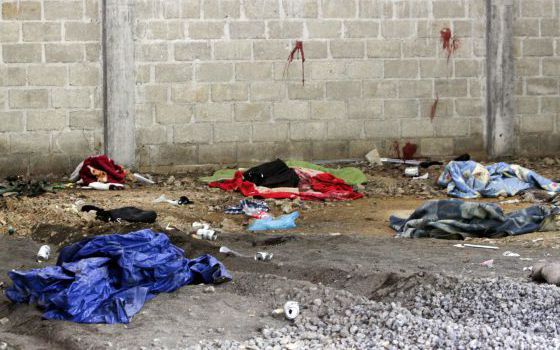
Crime scene where 22 alleged drug traffickers were killed in Mexico. / B. R. (AFP)
As Mexico’s big capos fall, criminal organizations are splintering into small, ultra-violent groups
Just before dusk, a man in a white coat entered the
intensive care unit where Crisóforo Rogelio Maldonado Jiménez was
hospitalized. He took out a gun with a silencer and shot the patient in
the chest and stomach. Then the stranger quietly left the hospital and
vanished into the darkness of the night with a group of accomplices.
This incident took place on December 14, 2012. Guerreros Unidos had just
killed the leader of the rival cartel, Los Rojos. A few days before,
Maldonado Jiménez had survived another assassination attempt where he
had gotten badly injured.
That crime marked the beginning of a spiral of violence
that has made Guerreros one of the Mexican authorities’ prime targets –
targets before whom Mexican soldiers do not hesitate. They simply point
and shoot, as they did on Monday morning in that dark cellar in
Cuadrilla Nueva, where they killed 22 alleged members of the clan. The
raid struck at the heart of the organization. It was the largest killing
of drug-related criminals by the military. Guerreros is the prototype
of the new cartel model in Mexico.
The fall of Mexico’s great capos (such as Chapo Guzmán
and Z-40) and constant police assaults have splintered large
organizations into smaller cells with strong territorial roots. The
golden age of the large cartel – the kind that served as an umbrella for
all local criminal activity – is over. The new model is a small group
whose illicit business goes beyond drug trafficking. These new
organizations also use extortion and kidnapping, federal intelligence
officers say.
The new model is a small group whose illicit business goes beyond trafficking, and includes extortion and kidnapping
Guerreros Unidos was founded after Arturo “The Boss of Bosses” Beltrán Leyva
was shot dead on December 16, 2009. His demise led to the growth of
many small organizations that tried to take over what was left of his
empire, which covered various franchises along the Pacific coast and in
the interior of the country. The fight over the dead man’s booty
unleashed a bloodbath. And a new leader emerged. Mario Casarrubias “Sapo
Guapo” Salgado stood out because of his efficient use of brutality.
Casarrubias Salgado, a former officer in Beltrán’s camp, decided to
start his own organization. To that end, he hired the fearsome personal
security guards of the late capo. Then, he began a war for control of
Mexico state, the largest region of the country. More than 70 people
died in that offensive. In 2013, his ambitions led him to Michoacan and
Guerrero, where he entered a turf war with the Familia Michoacana
cartel. Familia, which operates with its own sect-like norms, was under
the command of the messianic figure, Nazario Moreno González. The legendary drug boss was later killed on March 9, 2014.
One of its income streams comes from drug trafficking by
land, particularly through Chicago, where Casarrubias once lived. Still,
drugs only account for a fraction of the business. Now that we are in
the dark ages of “the great narco,” the new norm includes kidnapping,
extortion and kickback payments. “This last factor has made people feel
much more unsafe,” says Eduardo Guerrero, a former analyst in the
federal intelligence bureau. “Kidnappings have increased by 35 percent
and extortion cases by 30 percent,” he adds.
The crime rate has alarmed federal authorities, and they
fear that the wave of violence might spread from Mexico state (where in
2013 four out of 10 residents had been victims of a crime), to the
adjacent federal district of Mexico City. Despite its enormous rumbling open fronts in Tamaulipas
and Michoacán, the government has launched a campaign to hunt down the
members of Guerreros Unidos. On April 29, the 33-year-old Casarrubias
was arrested in Toluca. The navy, army and attorney general’s office all
participated in the operation. Crime czar Monte Alejandro Rubido later
gave the news of the arrest.
Last Monday, a military convoy shot dead 22 alleged drug
traffickers in Cuadrilla Nueva, a small town in the southern
agricultural region of Mexico state. The operation freed three women who
had reportedly been kidnapped. One soldier got injured. “Guerreros
Unidos is now flailing because of their capo’s arrest and the death of
22 of its hitmen,” notes Eduardo Guerrero. “There weren’t many of them,
although they were very violent.”
Authorities have not released any information on the identities of
the deceased. The operation was led by the military, an impenetrable
institution that operates autonomously despite accusations of
extrajudicial executions
No comments:
Post a Comment